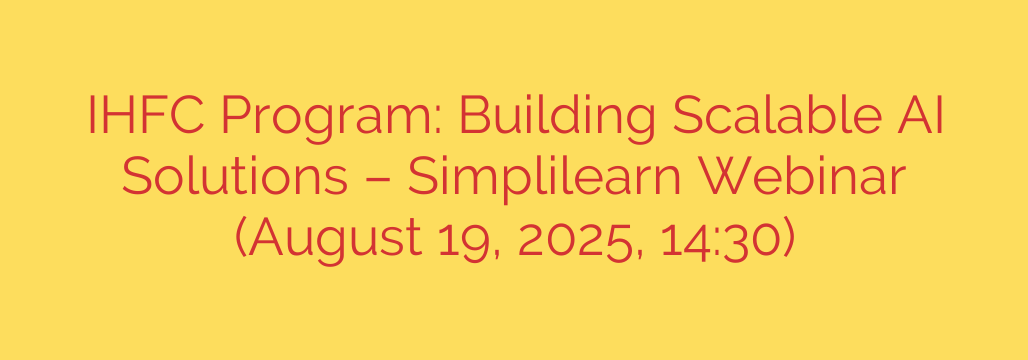
From Prototype to Production: A Guide to Building Scalable AI Solutions
Many promising artificial intelligence projects excel in a controlled environment but falter when faced with real-world demands. An AI model that works perfectly on a developer’s laptop can easily fail when deployed to serve thousands or even millions of users. The key to unlocking long-term value and avoiding this “pilot purgatory” lies in building scalable AI solutions from the ground up.
Scalability isn’t just about handling more traffic; it’s a strategic imperative that ensures your AI investment can grow with your business. It means designing systems that are efficient, reliable, and adaptable for the future.
Why AI Scalability is Non-Negotiable
Moving an AI model from a testing phase to a full-scale production environment is a complex challenge. Without a clear strategy for scalability, organizations face significant risks. Here’s why focusing on it from day one is critical:
- Long-Term Viability: An unscalable solution has a short shelf life. As your user base or data volume grows, the system’s performance will degrade, eventually becoming obsolete. A scalable architecture is future-proof.
- Cost-Effectiveness: A system that is not designed to scale often requires expensive, last-minute overhauls. Planning for growth allows you to manage infrastructure costs efficiently, allocating resources dynamically as needed rather than overprovisioning from the start.
- Enhanced User Experience: For customer-facing applications, performance is everything. A scalable AI ensures consistently fast response times and reliable service, which are crucial for maintaining user trust and satisfaction.
- Business Agility: A modular and scalable AI system allows you to adapt quickly. You can update models, add features, or integrate new data sources without having to redesign the entire framework.
The Core Pillars of a Scalable AI Architecture
Building a robust AI solution that can stand the test of time involves more than just writing code. It requires a holistic approach that considers the entire lifecycle of an AI model.
1. A Foundation of Robust Data Architecture
Scalable AI begins with scalable data. Your system’s ability to ingest, process, and store vast amounts of data is fundamental. This involves creating efficient data pipelines (ETL/ELT processes) that can handle both batch and real-time data streams. Utilizing technologies like data lakes and distributed processing frameworks ensures that your data infrastructure won’t become a bottleneck as your needs evolve.
2. Intelligent and Modular Model Design
Not all AI models are created equal. When building for scale, it’s essential to choose algorithms and architectures that are not only accurate but also computationally efficient. Furthermore, adopting a modular design is crucial. By breaking down a complex AI system into smaller, independent microservices, you can update, scale, or replace individual components without disrupting the entire application.
3. MLOps: The Engine of Scalability and Reliability
Machine Learning Operations (MLOps) is the bridge between AI development and IT operations. It applies DevOps principles to the machine learning lifecycle. Key MLOps practices include:
- Automation: Automating model training, testing, and deployment reduces manual errors and accelerates the release cycle.
- Continuous Integration/Continuous Deployment (CI/CD): CI/CD pipelines for machine learning ensure that every change is automatically tested and seamlessly deployed into production.
- Monitoring and Management: Actively monitoring a model’s performance in production is essential. This allows you to detect concept drift (when a model’s accuracy degrades over time) and trigger retraining processes automatically.
4. Choosing the Right Computing Infrastructure
The final piece of the puzzle is the underlying hardware and platform. Cloud computing platforms (like AWS, Google Cloud, and Azure) offer unparalleled scalability, allowing you to dynamically provision resources on demand. Technologies like Docker containers and Kubernetes orchestration have become the industry standard for deploying and managing scalable applications, including AI workloads. They provide consistency across different environments and simplify the management of complex, distributed systems.
Practical First Steps Toward Scalable AI
Whether you are just starting your AI journey or looking to improve existing systems, here are some actionable tips:
- Start with the End in Mind: During the initial design phase, always ask: “How will this work with 100x the data or 100x the users?” This mindset shifts the focus from a simple proof-of-concept to a production-ready system.
- Prioritize Your Data Pipeline: Before you even begin training a model, ensure your data collection and processing systems are clean, efficient, and scalable. A solid data foundation prevents countless problems down the line.
- Adopt MLOps Principles Early: Don’t wait until you have a deployment crisis to think about MLOps. Integrate automation and monitoring practices into your workflow from the very beginning.
- Focus on API-Driven Design: Expose your model’s functionality through a well-documented API. This makes it easier to integrate with other applications and facilitates a modular, microservices-based architecture.
Ultimately, building scalable AI solutions is not an afterthought—it is a core component of a successful AI strategy. By combining thoughtful design, robust MLOps practices, and the right infrastructure, organizations can transform their AI investments from exciting experiments into powerful, enduring business assets.
Source: https://www.simplilearn.com/ihfc-scalable-ai-solutions-program-webinar








